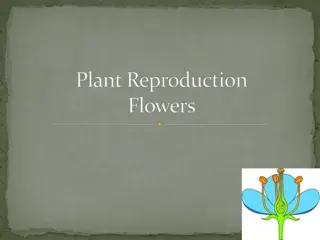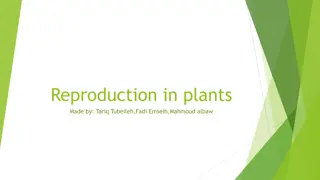Understanding Flower Dissection and Reproduction Process
Angiosperms are seed-bearing plants that produce flowers containing essential and accessory organs for reproductive functions. The stamen and pistil play key roles in the male and female reproductive processes, leading to fertilization and seed formation. Pollination, germination, and fruit development are essential stages in the flower's life cycle, vital for plant propagation.
Download Presentation

Please find below an Image/Link to download the presentation.
The content on the website is provided AS IS for your information and personal use only. It may not be sold, licensed, or shared on other websites without obtaining consent from the author. Download presentation by click this link. If you encounter any issues during the download, it is possible that the publisher has removed the file from their server.
E N D
Presentation Transcript
INTRODUCTION The angiosperms are seed-bearing plants that produce flowers. The seeds, which contain the plant embryo, are produced in the flower. All the parts of a flower are actually modified leaves that are specialized for their roles in the reproductive process. Flower parts are arranged in circles called whorls. They are attached at the enlarged base of the flower, the receptacle.
INTRODUCTION Flower structures can be divided into two groups: the essential organs and the accessory organs. The essential organs are the reproductive structures, which include the stamens (male) and the pistils (female). The accessory organs are the sepals and petals, which surround and protect the essential organs.
INTRODUCTION The stamen is the male reproductive organ and consists of two parts: the anther and the filament. The anther is the enlarged structure at the top of the stamen. Inside the anther are pollen sacs. Special cells within the pollen sacs undergo meiosis to form pollen grains. Each pollen grain contains two sperm nuclei. When the pollen grains mature, the pollen sacs split open to release the dust-like pollen. The filament is a thin stalk that supports the anther.
INTRODUCTION The pistil is the female reproductive organ and consists of three parts: the stigma, style, and ovary. The stigma is an enlarged portion at the top of the pistil that becomes sticky when mature. The style is the middle portion of the pistil. It can be long and slender, short, or even absent, depending upon the species. The ovary is the enlarged structure at the bottom of the pistil. The ovary contains one or more hollow compartments called locules. Each locule contains one or more ovules. Special cells within the ovule undergo meiosis to form ova (eggs) containing egg nuclei.
INTRODUCTION Pollination occurs when pollen grains land on the sticky surface of the stigma and are trapped there. The pollen grain germinates and a pollen tube emerges from the grain. It releases special enzymes that digest a cell the wall on the surface of the stigma. The pollen tube grows down through the style to the ovary and enters the ovule, making a continuous passageway for the two sperm nuclei to enter the ovum. Fertilization occurs when the sperm nuclei join the egg nuclei.
INTRODUCTION The fertilized egg becomes an embryo. The wall of the ovule thickens and forms a seed, thus enclosing and protecting the embryo. The ovary wall also thickens and develops into a fruit. In some plants such as apples, the ovary walls become fleshy and contain stored sugars and starches. In other plants such as walnuts, the ovary walls become dry and hard.
STEP 1 Obtain a single flower and observe its parts carefully. Identify the whorls and receptacles. As you examine your flower, you will be carefully removing parts beginning with the outer whorl and working your way in towards the pistil. You will arrange each whorl in a circle on the plain paper, beginning with the sepals as the largest outermost circle. As you proceed with your dissection, you will carefully tape each flower part into position and label them (please use pencil!). As each whorl is observed and removed, you will complete the appropriate information in the Observations column of the chart in your journal. Use the information in the handout to complete the Function column of the chart.
STEP 2 1. The sepals form the outermost whorl of the flower. The sepals are leaf-like structures that are usually green in color. 2. Gently remove the sepals, tape them into position onto the paper, and label them. On the chart, record the following observations: How many sepals does your flower have? Describe the appearance of the sepals (color, markings, etc.).
STEP 3 The petals are found directly under the sepals. The color and odor of the petals help to attract birds and insects to the flower for pollination. Gently remove the petals, tape them into position onto the paper, and label them. On the chart, record the following observations: a) How many petals does your flower have? b) Describe the appearance of the petals (color, markings, etc.).
STEP 4 The stalk-like structures inside the petals are the stamens, the male reproductive organs. The enlarged portion at the top of the stamen is the anther. Inside the anther are pollen sacs, which produce pollen grains. The filament is the thin structure that supports the anther. Gently remove the stamens, tape them into position onto the paper, and label them. On the chart, record the following observations: a) How many stamens does your flower have? b) To which structure(s) were the filaments attached? c) Have the pollen sacs opened? How can you tell? d) If pollen grains are visible, describe their appearance.
STEP 5 The central structure of the flower is the female reproductive organ, the pistil. The top of the pistil is the stigma. The style is the middle portion of the pistil. It supports the sigma. Some flowers lack a style. The ovary is the enlarged structure at the bottom of the pistil. The ovary contains one or more hollow compartments known as locules. The locules contain ovules, which in turn, contain the egg nuclei. Carefully remove the pistil by cutting it from the stem just under the ovary. Label the stigma and style. Cut a thin cross-wise section of the ovary and tape it under the stigma and style. Label the ovary wall, locules and ovules. Using the dissecting needle, carefully pick the ovules out of one of the locules. Try to estimate how many ovules are contained in one locule.
STEP 5, CONTINUED On the chart, record the following observations: a)What color is the pistil? b) Describe the appearance of the stigma. Is the stigma mature? How can you tell? d) Describe the appearance of the ovary. e) How many locules does the ovary contain? f) Approximately how many ovules are contained in one locule?
CER Question: How does pollination in a flower occur? Claim: Answer the question Evidence: Bring in evidence from your chart that led you to your claim. Reasoning: Any other information you can offer to back up your claim based on what you have learned today.























